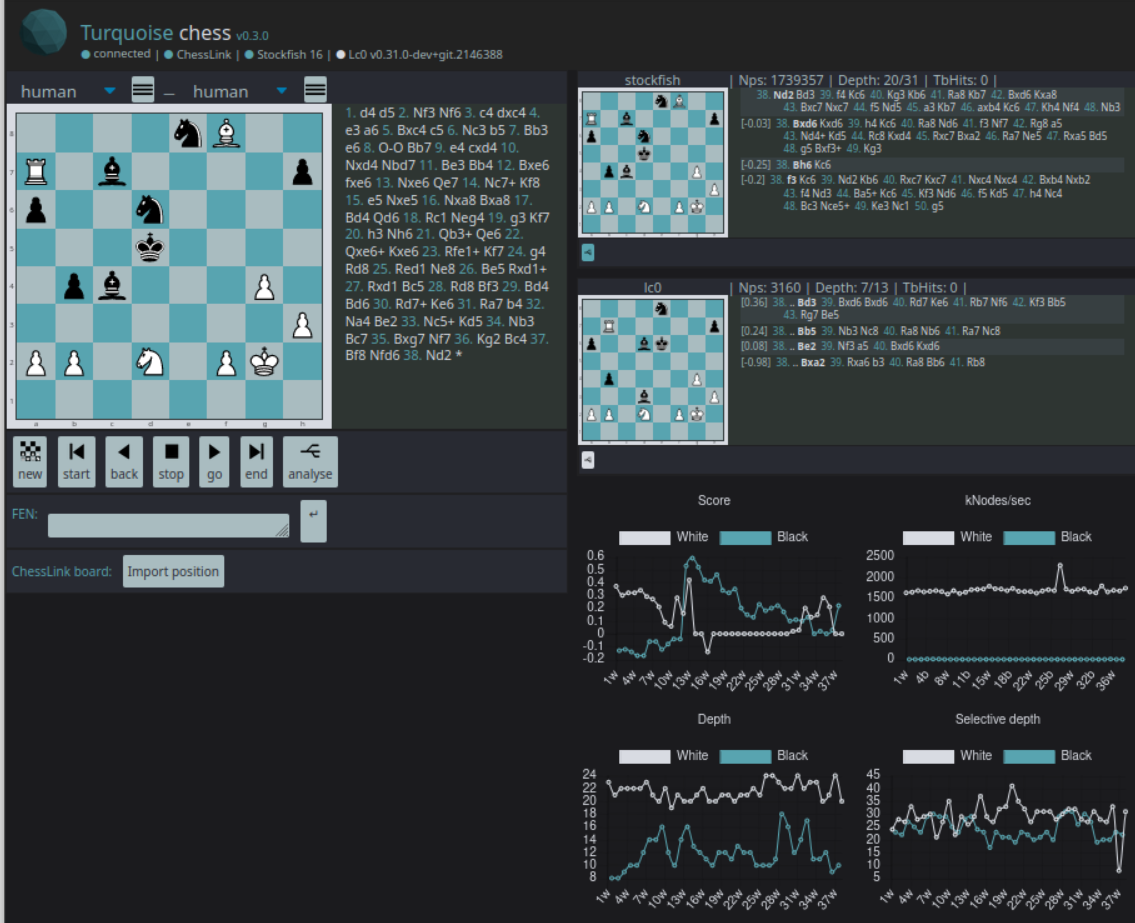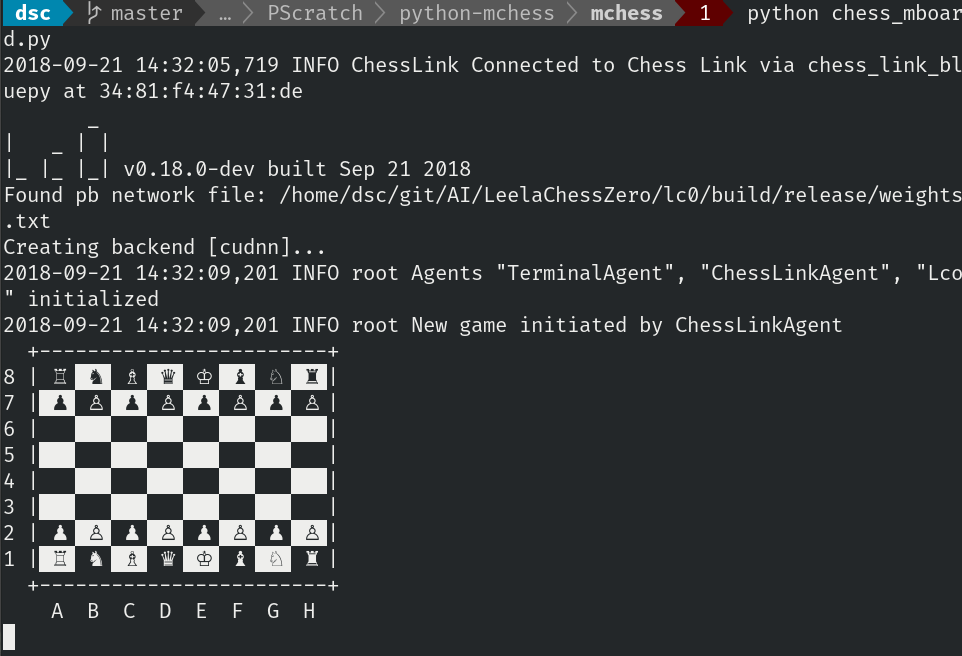python-mchess is a collections of libraries to work with Millennium's Chess Genius Exclusive chess board via the Chess Link interface.
It provides two layers of functionality:
- A hardware driver for the Chess Genius Exclusive chess board, supporting piece recognition and leds via USB or Bluetooth LE
- A sample implementation to connect arbitrary UCI engines to the chess board.
Currently, the following platforms are under development:
| Linux | Raspberry Pi | macOS | Windows | |
|---|---|---|---|---|
| USB | x | x | x | x |
| Bluetooth LE | x | x |
This project is under heavy development, and basically everything described below might change at some point.
python-mchess is written for Python 3.x
python-mchess board driver for Chess Link depends on PySerial and (Linux/Raspberry Pi only) BluePy
In order to use UCI engines with mchess, additionally python-chess is used.
pip3 install pyserial [bluepy] [python-chess]Then clone the repository
git clone https://github.com/domschl/python-mchessNow configure some engines:
cd mchess/enginesCopy engine-template.json for each UCI engine to a file <engine-name>.json, and edit the fields 'name' and 'path'.
A sample content for stockfish in Linux would be:
engines/stockfish.json:
{
"name": "stockfish",
"path": "/usr/bin/stockfish",
"active": true
}Note: Windows users need to use paths with \\ or / for proper json encoding.
The web agent requires python modules Flask, Flask-Sockets and gevent.
Node JS packet manager npm is needed to install the javascript dependencies:
cd mchess/web
npm installThis installs the dependencies Normalize.css and cm-chessboard.
Then in directory mchess, simply start from console:
python3 mchess.pyThis will start chess agents for the chess board, automatically detecting board hardware via USB or BLuetooth LE (Linux, Raspberry PI only), and load the [first active] UCI engine (testet with Leela Chess Zero (Lc0) and Stockfish 9).
Enter help in terminal to get an overview of available console commands (e.g. switch sides, take back moves, analyze position).
The web client can be reached at http://localhost:8001. From remote use http://computer-name:8001.

Note: Bluetooth LE hardware detection requires admin privileges for the one-time intial bluetooth scan. For first time start with Bluetooth LE support, use:
sudo python3 mchess.pyRestart the program, once the board has connected (the connection address is saved in chess_link_config.json)
Do NOT use sudo on subsequent starts, or the communication might fail.
Once the board is found, stop the program and restart without sudo. You might want to set ownership for chess_link_config.json to your user-account, since the file will be rewritten, if the detected board orientation is changed.
All engine descriptions in directory 'engines' will now contain the default-UCI options for each engine. Those can be edited e.g. to enable tablebases or other UCI options.

On start, the current position from Chess Genius Exclusive board is imported and displayed on the console.
Simply start making a move on the board, and the UCI engine will reply. During the time, the engine calculates,
the best current line is displayed on the board for up to 3 half-moves (see preferences.json to enable/disable this
feature).
Enter help on the terminal console to get an overview of commands, and see below for more customization options
Currrently, there doesn't exist much of a GUI to configure mchess, and configuration relies on a number of JSON files.
| Field | Default | Description |
|---|---|---|
think_ms |
500 |
Number of milli seconds, computer calculates for a move. Better level configuration will be added at a later point. |
use_unicode_figures |
true |
Most terminals can display Unicode chess figures, if that doesn't work, set to false, and letters are used for chess pieces instead. |
invert_term_color |
false |
How chess board colors black and white are displayed might depend on the background color of your terminal. Change, if black and white are mixed up. |
max_plies_terminal |
6 |
The number of half-moves (plies) that are displayed in analysis in terminal |
max_plies_board |
3 |
The number of half-moves that are indicated through blink led sequences on the Millennium chess board. Maximum (due to hardware protocol limitations) is 3. If more than one UCI engine is used for analysis, the results of the first engine are shown. |
ply_vis_delay |
80 |
The delay used went indicating move-sequences on the Millennium chess board. Use a higher value (e.g. 160) to slow down the speed of change. |
import_chesslink_position |
true |
On true the current position on the Millennium chess board is imported at start of mchess.py. On false, always the start position is used. |
computer_player_name |
stockfish |
Name of the first computer UCI engine. It must correspond to the name of a json file in mchess/engines/<computername>.json. The first computer_player is the actual oponent in human-computer games and is used for display of analysis on the Millennium board. Spelling (including case) must match engine filename and name field in <engine>.json. [This is not really an optimal solution and will change.] |
computer_player2_name |
"" |
Name of optional second UCI engine, used for computer-computer games and as second, concurrent analysis engine. |
human_name |
human |
Name of human player displayed in terminal. This will change (support for second name) |
active_agents |
{ "human": ["chess_link", "terminal", "web"], "computer": ["stockfish", "lc0"]} |
Work in progress! A list of active agent modules. The agent-architecture is very flexible and allow adding arbitrary input and output hard- and software or interfaces to remote sites. |
This file configures the Millennium chess board ChessLink hardware connection. This file is created during automatic hardware
detection at start of mchess.py.
A few caveats:
- Automatic Bluetooth-LE hardware detection (Linux only) requires root,
sudo python3 mchess.py. After successful hardware-detection,mchess.pyshould be restarted withoutsudo. - If
mchess.pyhas been started withsudo, it is advisible to change the ownership ofchess_link_config.jsonto the user account that is used for games, otherwisemchess.pycannot update the configuration (e.g. orientation changes) automatically. This will be simplified in the future.
| Field | Default | Description |
|---|---|---|
transport |
chess_link_usb |
Name of the Python module to connect to the ChessLink hardware, currently supported are chess_link_usb or chess_link_bluepy. It's possible to add additional implementations (e.g. macOS or Windows Bluetooth) at a later time. |
address |
"" |
Bluetooth address or USB port name. |
orientation |
true | Orientation of the Millennium chess board. The orientation is detected and saved automatically as soon as the start position is setup on the Millennium board. |
autodetect |
true |
On true, automatic hardware detection of Millennium ChessLink is tried on each start of mchess.py, if the default connection does not work. Setting to false disables automatic hardware detection (e.g. if no board hardware is available) |
Currently mchess supports up to two concurrent UCI chess engines. Each engine needs a configuration file mchess/engines/<engine-name>.json. On first start mchess.py automatically searches for stockfish, komodo and crafty.
The mandatory fields in <engine-name>.json are:
| Field | Default | Description |
|---|---|---|
name |
e.g. "stockfish" |
Name of executable of the engine, e.g. stockfish. Unfortunately this name must be precisely equal to the name of the json file, and must be referenced in preferences.json as either computer_player_name or computer_player2_name and within active_agents. That is subject to improvement in the future. |
path |
e.g. "/usr/local/bin/stockfish" |
Path to the engine executable. Windows users must either use \\ or / in json files as path separators. |
active |
true |
mchess.py currently uses only the first two active engines. If more engines are configured, the unused ones should be set to false |
Once the UCI engine is started for the first time, the UCI-options of the engine are enumerated and added to the <engine-name>.json config file. That allows further customization of each engine. Some commonly used options are:
| Field | Default | Description |
|---|---|---|
Threads |
1 |
Number of threads used for the engine, increase for higher engine performance. |
Hash |
"" |
Size of hash table, usually in MB. Increase for better performance |
MultiPV |
1 |
Increasing this shows more concurrent lines during analysis both on terminal and web client. A maximum of 4 is recommended, so not enforced. |
SyzygyPath |
"" |
Path to tablebase endgame databases. mchess outputs the number of tablebase references (TB) |
Warning: all customizations are reset, if an engine-update changes the available UCI-options. If a new engine version introduces new UCI-options, all fields are reset to engine-defaults.
Additionally a file <engine-name>-help.json is auto-created, it contains descriptions for each UCI-option, and will be used in
the future for an UCI-customization option.
+--------------------+
| mchess.py | Start and connect agents
+--------------------+ agents represent player activities
|
+----------------+---------------+----------------------+
| | | |
+---------------------+ +--------------+ +-------------------+ +--------------+
| chess_link_agent.py | | uci_agent.py | | terminal_agent.py | | web_agent.py |
+---------------------+ +--------------+ +-------------------+ +--------------+
| uci-engines I/O hardware multiple web
| Stockfish, clients
| Lc0 etc.
- - - - - - - - | - - - - - - - - - - - -
+---------------+
| chess_link.py | Python 3 chess link library, can be
+---------------+ reused for other projects without agents above
| |
+-------------------+ +----------------------+
| chess_link_usb.py | | chess_link_bluepy.py |
+-------------------+ +----------------------+
Chess Genius Exclusive board hardware
via Chess Link
It whould be straight forward to include other agents at a later point.
- Start with option
-vto get more logging output:
python3 mchess.py -v- Linux users: many distris require users to be be in group
DIALOUTin order to access USB and serials.
usermod -aG dialout <username>- ChessLink communication debug
Open chess_link_config.json and insert a line:
"protocol_debug": true,
like so:
{
"protocol_debug": true,
"transport": "chess_link_bluepy",
"address": "xx:xx:xx:xx:xx:xx",
"orientation": true,
"autodetect": true
}This will show bit-level communication with the ChessLink board.
API Documentation for chess_link.py
- Thanks to Millennium GmbH for providing all information necessary for the implementation and for providing a ChessLink sample. See: for more information on ChessLink.

